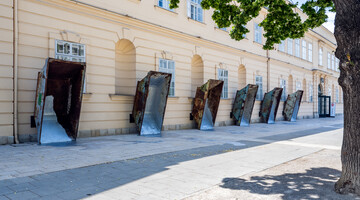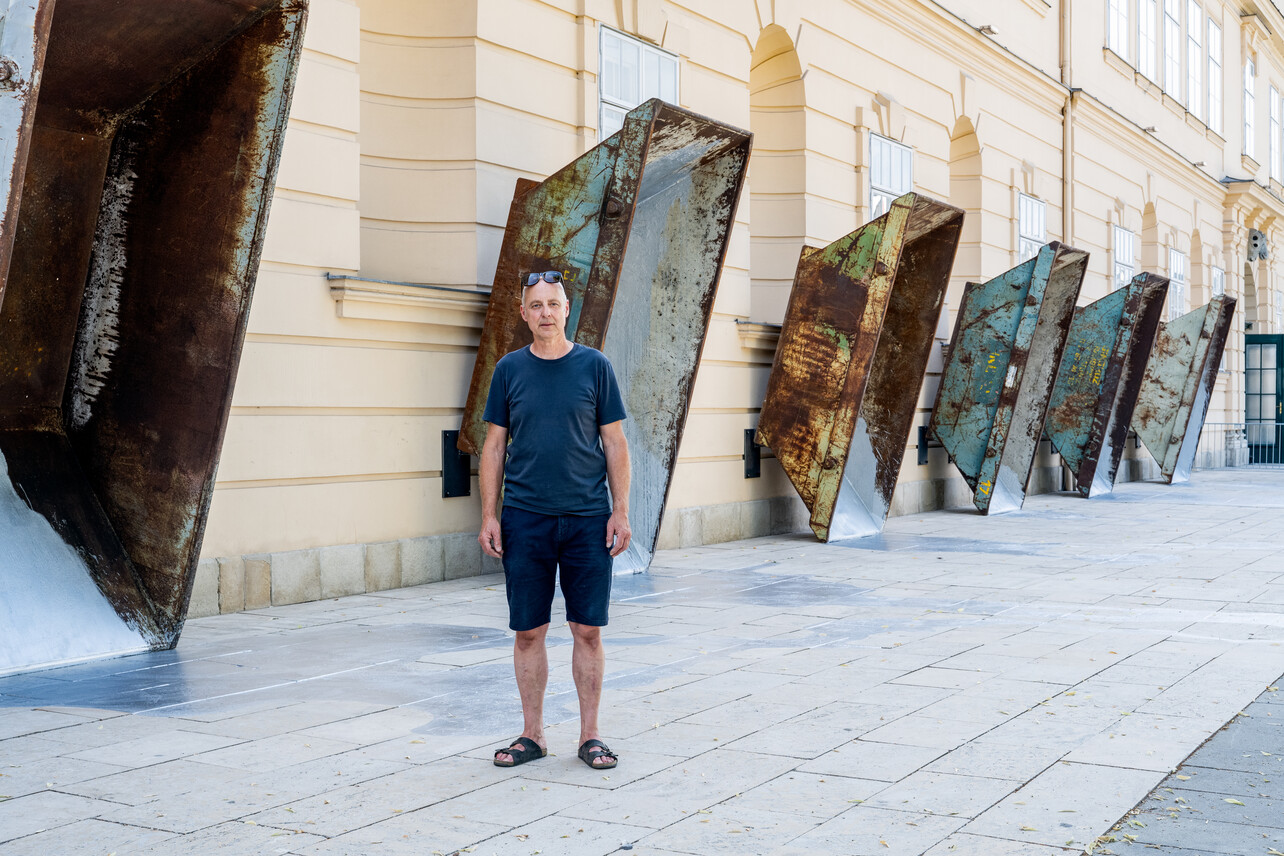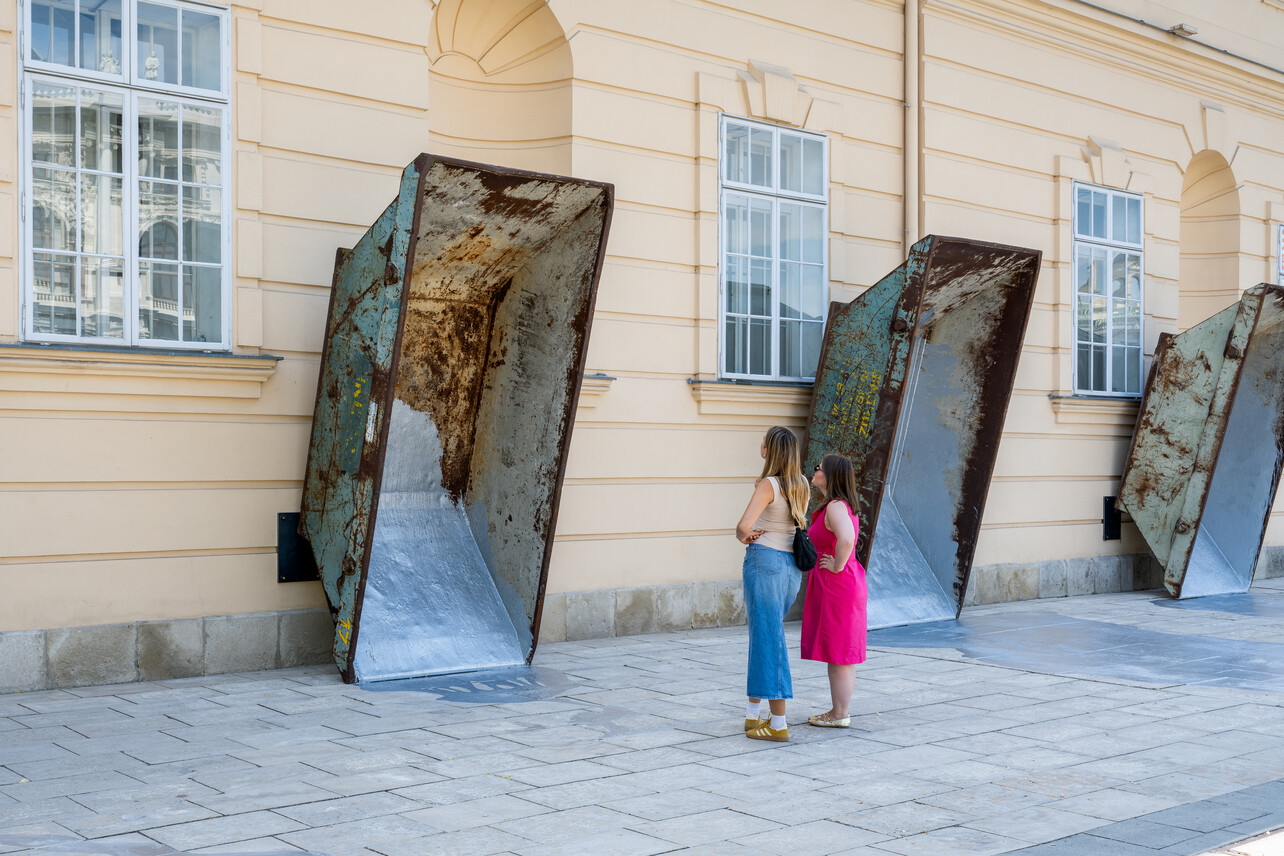
Interview with Reto Emch
An interview by MQ chief curator Verena Kaspar-Eisert with the artist Reto Emch about his installation Off-Balance.
The skips are transported from Solothurn to Vienna by rail – an act that far transcends the logistical. Would you say that the transport itself is a performative gesture, an integral part of the sculptural work?
Absolutely. Since I started out as an artist, it has been important to me to bring my interventions into public space. I follow several strategies in working with or processing art. These include developing and exploring a given work or form of artistic expression; artistic creation as realisation in the studio; the manual, creative process; and presenting the work in the exhibition space. Why undertake the route to the exhibition in closed boxes when you can show your work on the way there? For me, transporting the skips on a flatbed train carriage is a performance in itself. That's why they are arranged and positioned on the carriage in a specific way, not simply stacked on top of each other as they would be on a lorry. The inner surface with its silver paint faces outwards, so that the colour is reflected at night. The skips are meant to function like screens.
How do you understand the significance of transportation in the context of the art world, particularly in terms of its environmental implications? Do you set out explicitly to address the tension between global mobility and environmental responsibility: a real dilemma for many artists?
Explicitly addressing a given ecosystem is not my first impulse. My sculpture is simply sculpture. At the same time, it also incorporates painting: the skips are painter’s palettes, the spilled paint is the picture. The entire group is an installation. As such, it ought to appear majestic, and withstand criticism, too. If Off-Balance as an installation gives rise to different interpretations, then I am happy to encourage critical thinking.
Essentially, I believe it is important that people should travel, not art. But in today's global art market, this is practically impossible. Works of art are transported all over the world because museums want to showcase their highlights. This has become a billion-dollar business, and everyone profits from it in some way. Off-Balance expresses how we deal with all of this. From rubbish to be discarded, all the way to art-historical significance and investments worth millions. Today, everything is on the move. We are on the brink, and our position is precarious.
Off-Balance displays standard-issue skips in a precarious, almost dancer-like tilt – they tip over, they spill paint, they appear destabilised. What does this “imbalance” mean to you – in an artistic, social, perhaps even a personal sense?
Movement is everything. In Off-Balance, that moment of tipping is what conveys movement. It‘s like a pause, a reflection, followed by the expected sequence of events. For me, as an artist, art is most alive in the studio. That's where I build and experiment; where I work paint into pictures, material into objects, things into sculptures. The act of balancing is a necessary part of this process. It‘s a constant weighing up of decisions. For me, it‘s a very dynamic act.
Your works often oscillate between monumentalism and poetry, logistical effort and contemplative gestures. What appeals to you in this ambivalence of scale, fragility and materiality?
I‘m not afraid of grand gestures, and I like very small ones, too. The location has to be right. I really like the way the two come together. One of my earlier works was a large water basin eight metres in diameter, suspended freely from the eight columns in the centre of the Chapel of Saint-Louis de la Salpêtrière in Paris. The basin held 10,000 litres of water. The entire dome was reflected in the water. After a while, a single drop would fall into the basin from a height of 35 metres and shatter the surface of the water. The impact of this drop could be heard throughout the church, in the four side chapels and in the four cloisters. The water in this basin, an enormous mass consisting of millions of individual drops, absorbed one more, and so grew.
From a technical standpoint, it was very challenging to keep a falling drop in place over several dozen metres. At first, the drops kept falling out of shape. After many attempts, I finally found the solution. Mastering technical challenges like this requires just as much creativity and perseverance as creating a work of art.
You work with materials like iron, water, and light – ones that often have functional connotations. What role does materiality play for you, especially when it stems from industrial processes?
I like touching materials. The tactile aspect is important. It stimulates the senses. Take iron, for example. It‘s not just a metal. Iron is cold to the touch, or very hot. It‘s smooth and delicate, it can be fragile or stubborn. Kind or cruel. You have to know how to handle it. I process the material with my hands. For many years, I painted almost exclusively. I never used a brush. I had to feel the acrylic paint on my skin before I could apply it to the canvas. Today, I hardly paint anymore; instead, I spread paint around. I build devices for this purpose
Once the skips are in place, you use a device you developed yourself to pour silver paint into them, which then runs down and across the ground. Do you see this as a painterly move – a physical, gestural one in the spirit of action painting? Or is it more of a controlled, precisely calculated process that only appears random?
It is undoubtedly a physical, gestural action. Even if I use a drill-powered pump. I move around the image I am creating. The amount of pressure I apply to the paint is controlled, and the working area is defined in advance. However, it is more a matter of chance how the paint then flows according to the terrain, and how far my spontaneity and desire for action take me.
Silver intensifies the industrial feel of the work. It refers to material aesthetics and light reflection; perhaps also to notions of value, or surface. Did you choose this colour deliberately with those associations in mind?
I wanted to create a bright, reflective surface. To illustrate this, I can draw on an example that served as my inspiration. When you look at the surface of water rippling in bright sunlight, the glare from the sun‘s reflection is so strong that you can't even make out its colour. It‘s just very bright and dazzling. Sometimes it‘s so fierce that you can barely look at it. And yet you have to keep looking, because it‘s so fascinating. For Off-Balance, I wanted a colour that isn‘t colourful. Silver seemed to me the best counterpoint to the heavily rusted iron bodies, and unlike rust, it looks elegant. Perhaps sublime. It conveys pride. A pride that iron doesn‘t have.
Creating your large-scale installations requires you to work with numerous people from different fields. How do you view this form of collaboration? What role does it play in your artistic identity?
The interaction between very different areas is a real challenge. I meet craftspeople from all trades, and I get to learn from their knowledge and experience. For Off-Balance, I am working with locksmiths, ironworkers, exchanging ideas and experiences. Through joint experiments, we come up with solutions; but then we meet engineers and structure designers who have completely different ideas. Mastering this balancing act requires a lot of perseverance and patience. The metalworkers act on experience and common sense, the structural engineers on figures and tables, and the artists according to their dreams. Who ultimately decides what the artwork is? When you look at an installation like Off-Balance, you can‘t help thinking that it's just a few skips standing against the façade. The amount of work that goes into preparing it isn’t the point, but it‘s still massive. The mere requirement that the paint poured onto two separate stone slabs must be removable – and yet must remain in place for several months while exposed to large numbers of passers-by – necessitated a long series of experiments in the chemical laboratory of a sympathetic paint manufacturer. No such product was available on the market. It was developed specifically for this situation.
Do your ideas first emerge in isolation, from independent artistic reflection, or is interaction with others an early stage of the conceptual process?
Much of my work develops from my own mental images. They appear. They just come. It‘s not a dream or a daydream, more like a kind of switching off from everyday life. While I‘m observing a situation, during a conversation or a car journey, other images push their way in. You could call it isolation. A withdrawal into oneself, while at the same time remaining active. My partner Anet Fröhlicher is a choreographer. She develops her own projects and travels internationally. We discuss our projects, usually over dinner. Every day. This gives us a constant oeil extérieur. We both work across disciplines. My interventions extend into her stage design; her dance analyses leave a trace in my sculpture. It's a daily exchange that also influences the early stages of a project.
What do you want visitors to feel or perceive when they experience Off-Balance against the baroque façade of the MuseumsQuartier? Are you aiming for irritation, poetic displacement, social reflection – or perhaps a moment of reflection in urban space?
All these things that you have described so beautifully, thank you, Verena. And if all goes well, we will see a tiny smile on their lips.
Reto Emch Off–Balance
26.06. - 12.10.2025 l Installation in front of the MuseumsQuartier Wien
In his work Off–Balance, Swiss artist Reto Emch stages standard construction waste skips as precariously inclined sculptural forms. Silver paint slowly trickles over the edges of the tilted containers, leaving abstract traces on the ground – a controlled, yet poetically open gesture, evocative of action painting. The skips themselves – industrially manufactured, heavy and functional – become vessels for a delicate balance between control and chance, materiality and meaning, monumentality and fragility.


